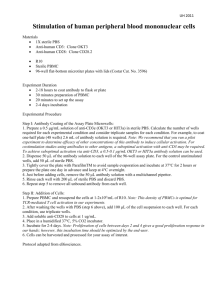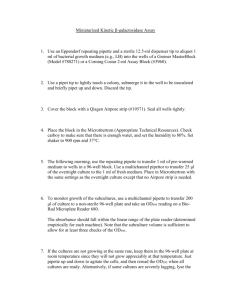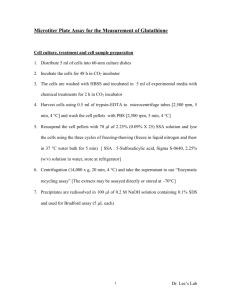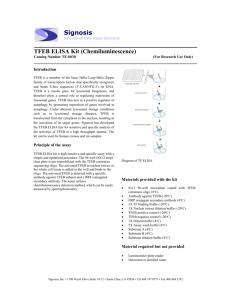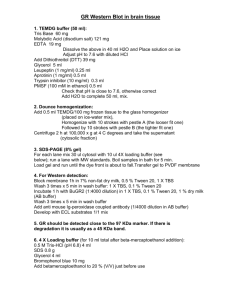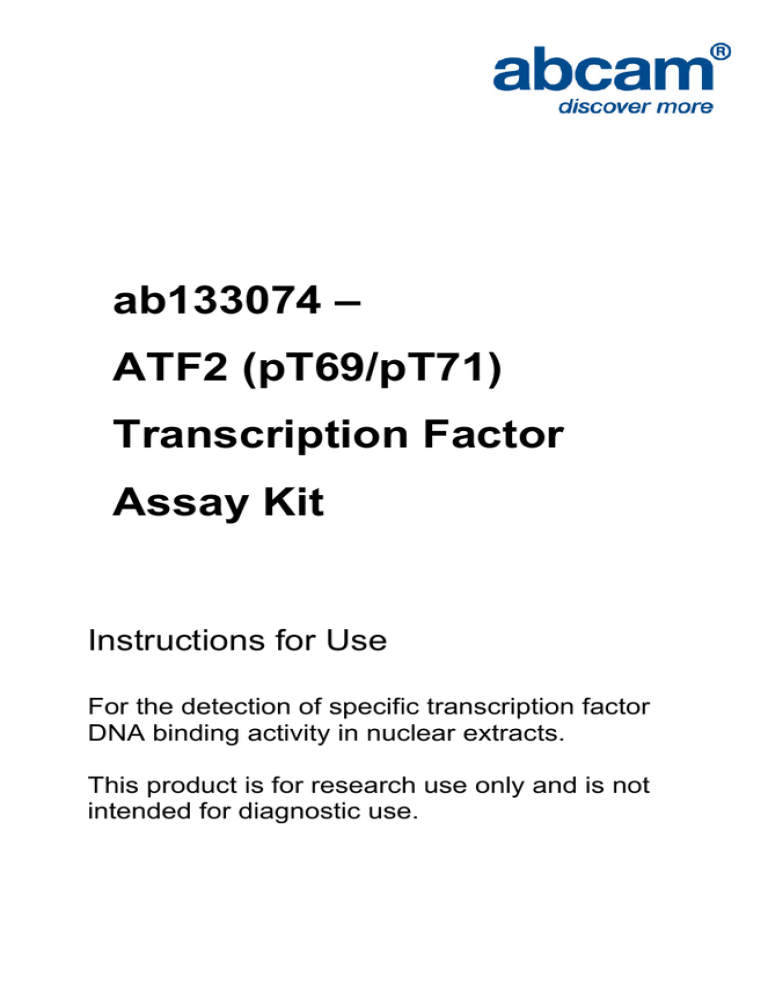
ab133074 –
ATF2 (pT69/pT71)
Transcription Factor
Assay Kit
Instructions for Use
For the detection of specific transcription factor
DNA binding activity in nuclear extracts.
This product is for research use only and is not
intended for diagnostic use.
1
Table of Contents
1.
Overview
3
2.
Background
5
3.
Components and Storage
6
4.
Pre-Assay Preparation
8
5.
Assay Protocol
15
6.
Data Analysis
24
7.
Troubleshooting
26
2
1. Overview
ab133074 is a non-radioactive, sensitive method for detecting
specific transcription factor DNA binding activity in nuclear extracts.
A 96-well enzyme-linked immunosorbent assay (ELISA) replaces the
cumbersome radioactive electrophoretic mobility shift assay (EMSA).
A specific double-stranded DNA (dsDNA) sequence containing the
cAMP-response element (CRE) is immobilized onto the wells of a
96-well plate (figure 1). ATF2 contained in a nuclear extract, binds
specifically to the CRE. The activated ATF2 transcription factor
complex is detected by addition of a specific primary antibody
directed against the phospho-Thr69,71 epitope on ATF2. A secondary
antibody conjugated to HRP is added to provide a sensitive
colorimetric readout at 450 nm.
3
Figure 1. Schematic of the Transcription Factor Binding Assay
4
2. Background
ATF2 (Activating Transcription Factor 2) is a sequence-specific
DNA-binding protein belonging to the bZIP family of transcription
factors that bind with high affinity to the octameric cyclic AMPresponsive element (CRE) in the promoter region of target genes.
ATF2 mediates both transcription and DNA damage control through
its phosphorylation/activation in response to inflammatory cytokines,
UV irradiation, alkylating compounds, and other cellular stressors.
The activated Phospho-Thr69,71 species of ATF2 (pThr69,71 ATF2;
phosphorylated at both Thr69 and Thr71) is specifically mediated by
JNK/p38. Phospho-Thr69,71 ATF2 can form homodimers or selective
heterodimers with other members of the ATF/CREB family including
Fos, Fra2, c-Jun, CREB and ATF1, yielding a diverse array of DNAbinding complexes which contribute to regulatory specificity among
bZIP family proteins. Recent studies implicate the ATF/CREB family
of transcription factors in key cellular processes including cell cycle
control, drug resistance, apoptosis, tumorigenesis, and insulin
biosynthesis.
5
3. Components and Storage
Kit components may be stored at -20°C prior to use. For long-term
storage, the positive control should be thawed on ice, aliquoted at
20µl/vial, and stored at -80°C. After use we recommend each kit
component be stored according to the temperature listed below.
Item
Quantity
Storage
1 vial
4°C
1
4°C
Transcription Factor Developing Solution
1
4°C
Transcription Factor Stop Solution
1
4°C
Transcription Factor Reagent A
1
-20°C
Transcription Factor Goat Anti-Mouse HRP
1
-20°C
1
RT
5 ml
RT
1
-80°C
Transcription Factor Binding Assay Buffer (4X)
Transcription Factor Antibody Binding Buffer
(10X)
Conjugate
Polysorbate 20
Wash Buffer Concentrate (400X)
TF ATF2 (Phospho-Thr69,71) Positive Control
6
Item
Quantity
Storage
TF ATF2 (Phospho-Thr69,71) Primary Antibody
1
-20°C
TF ATF2 (Phospho-Thr69,71) Competitor dsDNA
1
-20°C
TF ATF2 (Phospho-Thr69,71) 96-Well Strip Plate
1 plate
4°C
96-well cover sheet
1 cover
RT
Materials Needed But Not Supplied
A plate reader capable of measuring absorbance at 450 nm.
Adjustable pipettes and a repeat pipettor.
A source of UltraPure water or HPLC-grade water are
acceptable.
300 nM dithiothreitol (DTT).
Nuclear extraction kit or buffers for preparation of nuclear
extracts.
Note: The components in each kit lot have been quality assured and
warranted in this specific combination only; please do not mix them
with components from other lots.
7
4. Pre-Assay Preparation
A. Sample Buffer Preparation
PBS (10X)
0.038 M NaH2PO4, 0.162 M Na2HPO4, 1.5 M NaCl, pH 7.5
PBS (1X)
Dilute 100 ml of 10X stock with 900 ml distilled H2O
Nuclear Extraction Phophatase Inhibitor Cocktail (50X)
0.05 M β-glycerophosphate, 0.05 M Na3OV4, store at -80°C.
PBS/Phosphatatase Inhibitor Solution
Add 200 μl of 50X Phosphatase Inhibitor Solution to 10 ml of 1X
PBS, mix well, and keep on ice. Make fresh daily.
Nuclear Extraction Protease Inhibitor Cocktail (100X)
10 mM AEBSF, 0.5 mM Bestatin, 0.2 mM Leupeptin Hemisulfate
Salt, 0.15 mM E-64, 0.1 mM Pepstatin A, 0.008 mM Aprotinin
from Bovine Lung, Made in DMSO, store at -80°C.
Nuclear Extraction Hypotonic Buffer (10X)
100 mM HEPES pH 7.5, containing 40 mM NaF, 10 μM
Na2MoO4, and 0.1 mM EDTA. Store at 4°C.
8
Complete Extraction Hypotonic Buffer (1X)
Prepare as outlined in Table 1. The phosphatase and protease
inhibitors lose activity shortly after dilution; therefore any unused
1X Complete Extraction Hypotonic Buffer should be discarded.
Reagent
150 mm plate
~1.5 x 107 cells
Hypotonic Buffer (10X)
100 µl
Phosphatase Inhibitors (50X)
20 μl
Protease Inhibitors (100X)
10 μl
Distilled water
870 μl
Total Volume
1000 µl
Table 1. Preparation of Complete Extraction Hypotonic Buffer
Nonidet P-40 Assay Reagent (10%)
Nonidet P-40 or suitable substitute at a concentration of 10%
(v/v) in H2O. Store at room temperature.
9
Nuclear Extraction Buffer (2X)
20 mM HEPES, pH 7.9, containing, 0.2 mM EDTA, 3 mM MgCl2,
840 mM NaCl, and 20% glycerol (v/v). Store at 4°C.
Complete Nuclear Extraction Buffer (1X)
Prepare as outlined in Table 2. Some of the phosphatase and
protease inhibitors lose activity shortly after dilution; therefore
any remaining 1X Extraction Buffer should be discarded.
Reagent
150 mm plate
~1.5 x 107 cells
Nuclear Extraction Buffer (2X)
75 µl
Protease Inhibitors (100X)
1.5 μl
Phosphatase Inhibitors (50X)
3 μl
DTT (10 mM)
15 μl
Distilled Water
55.5 μl
Total Volume
150 µl
Table 2. Preparation of Complete Nuclear Extraction Buffer
10
B. Purification of Cellular Nuclear Extracts
The procedure described below can be used for a 15 ml cell
suspension grown in a T75 flask or adherent cells (100 mm dish
80-90% confluent) where 107 cells yields approximately 50 μg of
nuclear protein.
1. Collect ~107 cells in pre-chilled 15 ml tubes.
2. Centrifuge suspended cells at 300 x g for five minutes at
4°C.
3. Discard the supernatant. Resuspend cell pellet in 5 ml of
ice-cold
PBS/Phosphatase
Inhibitor
Solution
and
centrifuge at 300 x g for five minutes at 4°C. Repeat one
time.
4. Discard the supernatant. Add 500 μl ice-cold 1X
Hypotonic buffer. Mix gently by pipetting and transfer
resuspended
pellet
to
a
pre-chilled
1.5
ml
microcentrifuge tube.
5. Incubate cells on ice for 15 minutes allowing cells to
swell.
6. Add 100 μl of 10% Nonidet P-40 (or suitable substitute).
Mix gently by pipetting.
11
7. Centrifuge for 30 seconds (pulse spin) at 4°C in a
microcentrifuge.
Transfer
the
supernatant
which
contains the cytosolic fraction to a new tube and store at
-80°C.
8. Resuspend the pellet in 100 μl ice-cold Complete
Nuclear Extraction Buffer (1X) (with protease and
phosphatase inhibitors). Vortex 15 seconds at highest
setting then gently rock the tube on ice for 15 minutes
using a shaking platform. Vortex sample for 30 seconds
at highest setting and gently rock for an additional 15
minutes.
9. Centrifuge at 14,000 x g for 10 minutes at 4°C. The
supernatant contains the nuclear fraction. Aliquot to
clean chilled tubes, flash freeze and store at -80°C.
Avoid freeze/thaw cycles. The extracts are ready to use
in the assay.
10. Keep a small aliquot of the nuclear extract to quantitate
the protein concentration.
12
C. Reagent Preparation
Transcription Factor Antibody Binding Buffer (10X)
One vial contains 3 ml of a 10X stock of Transcription Factor
Antibody Binding Buffer (ABB) to be used for diluting the primary
and secondary antibodies. To prepare 1X ABB dilute 1:10 by
adding 27 ml of UltraPure water. Store at 4°C for up to six
months.
Wash Buffer Concentrate (400X)
One vial contains 5 ml of 400X Wash Buffer. Dilute the contents
of the vial to a total volume of 2 liters with UltraPure water and
add 1 ml of Polysorbate 20. NOTE: Polysorbate 20 is a viscous
liquid and cannot be measured by a pipette. A positive
displacement device such as a syringe should be used to deliver
small quantities accurately. A smaller volume of Wash Buffer
Concentrate can be prepared by diluting the Wash Buffer
Concentrate 1:400 and adding Polysorbate 20 (0.5 ml/liter of
Wash Buffer). Store at 4°C for up to two months.
Transcription Factor Binding Assay Buffer (4X)
One vial contains 3 ml of a 4X stock of Transcription Factor
Binding Assay Buffer (TFB). Prepare Complete Transcription
Factor Binding Assay Buffer (CTFB) immediately prior to use in
1.5 ml centrifuge tubes or 15 ml conical tubes as outlined in
13
Table 3. This buffer is now referred to as CTFB. It is
recommended that the CTFB be used the same day it is
prepared.
Component
Volume/Well
Volume/Strip
Volume/
96-well
plate
UltraPure Water
73 µl
584 µl
7008 µl
Transcription Factor
25μl
200 μl
2,400 μl
Reagent A
1 μl
8 μl
96 μl
300 mM DTT
1 μl
8 μl
96 μl
100 μl
800 μl
9,600 μl
Binding Assay Buffer (4X)
Total Required
Table 3. Preparation of Complete Transcription Factor Binding Assay
Buffer.
14
TF ATF2 (Phospho-Thr69,71) Positive Control
One vial contains 150 μl of Anisomycin-treated HeLa cell nuclear
extract. This nuclear extract is provided as a positive control for
phospho-Thr69,71 ATF2; it is not intended for plate to plate
comparisons. The Positive Control provided is sufficient for 15
reactions and will provide a strong signal (>0.5 AU at 450 nm) when
used at 10 μl/well. When using this Positive Control, a decrease in
signal
may
occur
with
repeated
freeze/thaw
cycles.
It
is
recommended that the Positive Control be aliquoted at 20 μl per vial
and stored at -80°C to avoid loss in signal from repeated freeze/thaw
cycles.
5. Assay Protocol
A. Summary
Note: This procedure is provided as a quick reference for
experienced users. Follow the detailed procedure when initially
performing the assay.
Prepare CTFB as directed in the Pre-Assay Preparation
section.
Add CTFB to Blk and NSB wells.
15
Add Competitor dsDNA (optional) to appropriate wells.
Add positive control to appropriate wells.
Add sample containing phosphor-Thr69, 71 ATF2 to
appropriate wells.
Incubate overnight at 4°C without agitation.
Wash each well 5 times with 1X wash buffer.
Add diluted phosphor-Thr69, 71 ATF2 primary antibody to
each well (except blk wells).
Incubate at RT without agitation.
Wash each well 5 times with 1X Wash Buffer.
16
Add diluted Goat Anti-Mouse HRP Conjugate (except Blk
wells).
Incubate at RT without agitation.
Wash each well 5 times with 1X Wash Buffer.
Add Developing Solution to wells and incubate with gentle
agitation.
Add Stop Solution to wells.
Measure the absorbance.
17
B. Plate Setup
There is no specific pattern for using the wells on the plate. A
typical layout of phospho-Thr69,71 ATF2 Positive Control (PC),
Competitor dsDNA (C1), and samples of nuclear extracts (S1S44) to be measured in duplicate is given below in Figure 2. We
suggest you record the contents of each well.
S1-S44 – Sample Wells
NSB – Non-specific Binding Wells
PC – Positive Control Wells
Blk – Blank Wells
C1 – Competitor dsDNA Wells
18
Pipetting Hints:
Use different tips to pipette each reagent.
Before pipetting each reagent, equilibrate the pipette tip
in that reagent (i.e., slowly fill the tip and gently expel the
contents, repeat several times).
Do not expose the pipette tip to the reagent(s) already in
the well.
General Information:
It is not necessary to use all the wells on the plate at one
time; however a positive control should be run every
time.
For each plate or set of strips it is recommended that two
Blk, two Non-Specific Binding (NSB), and two PC wells
be included.
C. Performing the Assay
Binding of active Phospho-Thr69, 71 ATF2 to the consensus
sequence
1. Equilibrate the plate and buffers to room temperature prior to
opening. Remove the plate from the foil and select the
number of strips needed. The 96-well plate supplied with this
kit is ready to use.
19
NOTE: If you are not using all of the strips at once, place the
unused strips back in the plate packet and store at 2-4°C. Be
sure that the packet is sealed with the desiccant inside.
2. Prepare the CTFB as outlined in Table 3.
3. Add appropriate amount of reagent(s) listed below to the
designated wells as follows:
Blk - add 100 μl of CTFB to designated wells.
NSB - add 100 μl of CTFB to designated wells. Do not add
samples or Positive Control to these wells.
C1 - Add 80 μl of CTFB prior to adding 10 μl of TF ATF2
(Phospho-Thr69,71) Competitor dsDNA to designated wells.
Add 10 μl of control cell lysate, or unknown sample.
NOTE: Competitor dsDNA must be added prior to adding the
positive control or nuclear extracts.
S1-S44 - Add 90 μl of CTFB followed by 10 μl of Nuclear
Extract to designated wells. A protocol for isolation of
nuclear extracts is provided in section 4.
PC - Add 90 μl of CTFB followed by 10 μl of Positive Control
to appropriate wells.
20
4. Use the cover provided to seal the plate. Incubate overnight
at 4°C or one hour at room temperature without agitation
(incubation for one hour will result in a less sensitive assay).
5. Empty the wells and wash five times with 200 μl of 1X Wash
Buffer. After each wash empty the wells in the sink. After the
final wash (wash #5), tap the plate on a paper towel to
remove any residual Wash Buffer.
Addition of TF ATF2 (Phospho-Thr69,71) Primary Antibody
1. Dilute the TF ATF2 (Phospho-Thr69,71) Primary Antibody
1:100 in 1X ABB as outlined in Table 4 below. Add 100 μl of
diluted Phospho-Thr69,71 ATF2 Primary Antibody to each well
except the Blk wells as outlined in Table 4 below.
Component
Volume/Well
Volume/Strip
Volume/
96-well plate
1X ABB
99 µl
792 µl
9504 µl
Phospho-Thr69,71
1 µl
8 µl
96 µl
100 µl
800 µl
9600 µl
ATF2 Primary
Antibody
Total Required
Table 4. Dilution of Primary Antibody.
21
2. Use the adhesive cover provided to seal the plate.
3. Incubate for one hour at room temperature without agitation.
4. Empty the wells and wash five times with 200 μl of 1X Wash
Buffer. After each wash, empty the contents of the plate into
the sink. After the final wash (wash #5), tap the plate three to
five times on a paper towel to remove any residual Wash
Buffer.
Addition of Transcription Factor Goat Anti-Mouse HRP
Conjugate
1. Dilute the Transcription Factor Goat Anti-Mouse HRP
Conjugate 1:100 in 1X ABB as outlined in Table 5 below.
Add 100 μl of diluted secondary antibody to each well except
the Blk wells.
Component
Volume/Well
Volume/Strip
Volume/
96-well plate
1X ABB
99 µl
792 µl
9504 µl
Goat Anti-Mouse HRP
1 µl
8 µl
96 µl
100 µl
800 µl
9600 µl
Conjugate
Total Required
Table 5. Dilution of Secondary Antibody
22
2. Use the adhesive cover provided to seal the plate.
3. Incubate for one hour at room temperature without agitation.
4. Empty the wells and wash five times with 200 μl of 1X Wash
Buffer. After each wash, empty the contents of the plate into
the sink. After the final wash (wash #5), tap the plate three to
five times on a paper towel to remove any residual Wash
Buffer.
Develop and Read the Plate
1. To each well being used add 100 μl of Transcription Factor
Developing Solution which has been equilibrated to room
temperature.
2. Incubate the plate for 15 to 45 minutes at room temperature
with gentle agitation protected from light. Allow the wells to
turn medium to dark blue prior to adding Transcription Factor
Stop Solution (This reaction can be monitored by taking
absorbance measurements at 655 nm prior to stopping the
reactions; an OD655 of 0.4 to 0.5 yields an OD450 of
approximately 1). Monitor development of sample wells to
ensure adequate color development prior to stopping the
reaction. NOTE: Do not overdevelop; however Positive
Control wells may need to overdevelop to allow adequate
color development in sample wells.
23
3. Add 100 μl of Stop Solution per well being used. The
solution within the wells will change from blue to yellow after
adding the Stop Solution.
4. Read absorbance at 450 nm within five minutes of adding
the Stop Solution. Blank the plate reader according to the
manufacturer’s requirements using the blank wells.
6. Data Analysis
A. Performance Characteristics
Figure 3. Assay of phosphor-Thr69,71 ATF2 from anisomycinstimulated HeLa nuclear fraction.
24
B. Interferences
The following reagents were tested for interference in the assay.
Reagent
Will Interfere (Yes or No)
EGTA (≤ mM)
No
EDTA (≤ 0.5 mM)
No
ZnCl (any concentration)
Yes
DTT (between 1 and 5 mM)
No
Dimethylsulfoxide (≤ 1.5%)
No
25
7. Troubleshooting
Problem
Possible Causes
Recommended Solutions
No signal or
weak signal
in all wells
A. Omission of key reagent
A. Check that all reagents
have been added and in
the correct order.
Perform the assay using
the positive control
B. Plate reader settings not
correct
C. Reagent/reagents
expired
D. Salt concentrations
affected binding
between DNA and
protein
E. Developing reagent not
added to correct volume
B. Check wavelength
setting on plate reader
and change to 450 nm
C. Check expiration date
on reagents
D. Reduce the amount of
nuclear extract used in
the assay, or reduce the
amount of salt in the
nuclear extracts
(alternatively can
perform buffer
exchange)
E. Prewarm the
Developing Solution to
room temperature prior
to use
F. Check pipettes to
ensure correct amount
of developing solution
26
Problem
Possible Causes
Recommended Solutions
was added to wells
High signal
in all wells
A. Incorrect dilution of
antibody (too high)
A. Check antibody
dilutions and use
amounts outlined in
instructions
B. Improper/inadequate
washing of wells
C. Over-developing
B. Follow the protocol for
washing wells using the
correct number of times
and volumes
C. Decrease the incubation
time when using the
developing reagent
High
background
(NSB)
Incorrect dilution of antibody
(too high)
Check antibody dilutions
and use amounts outlined in
the instructions
Weak signal
in sample
wells
A. Sample concentration is
too low
A. Increase the amount of
nuclear extract used;
loss of signal can occur
with multiple
freeze/thaw cycles of
the sample; prepare
fresh nuclear extracts
and aliquot as outlined
in product insert
B. Incorrect dilution of
antibody
C. Salt concentrations
affecting binding
between DNA and
protein
B. Check antibody
dilutions and use
amounts outlined in the
instructions
27
Problem
Possible Causes
Recommended Solutions
C. Reduce the amount of
nuclear extract used in
the assay or reduce the
amount of salt in the
nuclear extracts
(alternatively can
perform buffer
exchange)
28
29
30
UK, EU and ROW
Email:technical@abcam.com
Tel: +44 (0)1223 696000
www.abcam.com
US, Canada and Latin America
Email: us.technical@abcam.com
Tel: 888-77-ABCAM (22226)
www.abcam.com
China and Asia Pacific
Email: hk.technical@abcam.com
Tel: 108008523689 (中國聯通)
www.abcam.cn
Japan
Email: technical@abcam.co.jp
Tel: +81-(0)3-6231-0940
www.abcam.co.jp
31
Copyright © 2012 Abcam, All Rights Reserved. The Abcam logo is a registered trademark.
All information / detail is correct at time of going to print.


